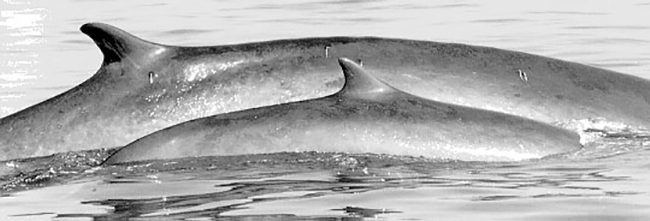Long-term photo-identification study of fin whales in the Pelagos Sanctuary (NW Mediterranean) as a baseline for targeted conservation and mitigation measures
A new scientific article based on the first two decades of data collected in the Ligurian Sea has recently been published on the journal “Aquatic Conservation: Marine and Freshwater Ecosystems”. The paper is an important foundation for the research and conservation of the population of fin whales (Balaenoptera physalus) living in the Pelagos Sanctuary.
Authors: Margherita Zanardelli, Sabina Airoldi , Martine Bérubé, J. Fabrizio Borsani, Nathalie Di Meglio, Alexandre Gannier, Philip S. Hammond, Maddalena Jahoda, Giancarlo Lauriano, Giuseppe Notarbartolo di Sciara, Simone Panigada.
When Tethys began studying cetaceans in the northwestern Mediterranean on a regular basis, fin whales were actually the most iconic animals. They are the second largest species ever to exist on the planet, yet they are regularly present in the “small” Mediterranean sea; however, little was known about them aside from information obtained from occasional beached animals.
Several questions arised at the time: how many fin whales were living in the Sanctuary? Were they always the same individuals coming to this summer feeding ground or were they occasional visitors from the Atlantic? But above all: was this a viable population or was their conservation at risk?
A very effective technique for studying cetaceans is photo identification, which allows each individual to be described and recognized at a new sighting. Tethys was the first to create a catalogue of fin whales of the Pelagos Sanctuary and to date the Institute holds the longest dataset of its kind (including other regular cetacean species in the study area of the Cetacean Sanctuary Research project). It may be hard to believe how much information those records, updated for decades, can contain.
The work, authored by Margherita Zanardelli and other Tethys researchers, together with colleagues from 3 other international institutes, spans almost 20 years, from 1990 to 2007; it merges pretty much all catalogues of this species in the area, and it is among the foundations on which research in the Ligurian and Corsican sea still rests today.
In addition to the authors, there are many collaborators, organizations, sponsors, skippers and above all the citizen science participants, who made an uninterrupted monitoring of the cetaceans of the Pelagos Sanctuary possible, and still do so year after year. Our heartfelt thanks goes to all of them.
Maddalena Jahoda
The full article is available from the Wiley Online Library or it can be read for free online
Abstract
- Historical abundance estimates are important for establishing baselines from which trends can be determined using more recent data. Long-term studies based on photo-identification were merged and used to estimate population size, survival rate and sex ratio (biopsy sampling) of fin whales in the North-western Mediterranean.
- Merging four existing photo-id catalogues yielded a Mediterranean catalogue with 507 individually identified fin whales. Ninety-five (18.7%) individuals were resighted at least once during the study period (1990–2007): 71 whales were resighted in different years, 24 within the same season and 13 both in the same season and in different years. The number of resightings within-season ranged from one to four, over periods from 1 to 90 days.
- Capture histories from these individuals were used in the capture–recapture analyses. Estimates of the animals present in the area each year between 1991 and 1995 through different modelling approaches were consistent: 900–1,000 from a POPAN open population model; 1,200 from a multi-sample closed population model; and 900–1,100 from simple two-sample closed population models for pairs of consecutive years, all with heavily overlapping 95% confidence intervals.
- The estimated apparent survival rate of 0.916 (95% CI = 0.773–972) was lower than expected, which may be linked to temporary or permanent emigration, or mortality possibly owing to ship strikes.
- Conservation and mitigation measures such as Important Marine Mammal Areas and Particularly Sensitive Sea Areas are presented and discussed.
Citation: Zanardelli, M., Airoldi, S., Bérubé, M., Borsani, J.F., Di-Meglio, N., Gannier, A. et al. (2022). Long-term photo-identification study of fin whales in the Pelagos Sanctuary (NW Mediterranean) as a baseline for targeted conservation and mitigation measures. Aquatic Conservation: Marine and Freshwater Ecosystems, 1–14. https://doi.org/10.1002/aqc.3865









